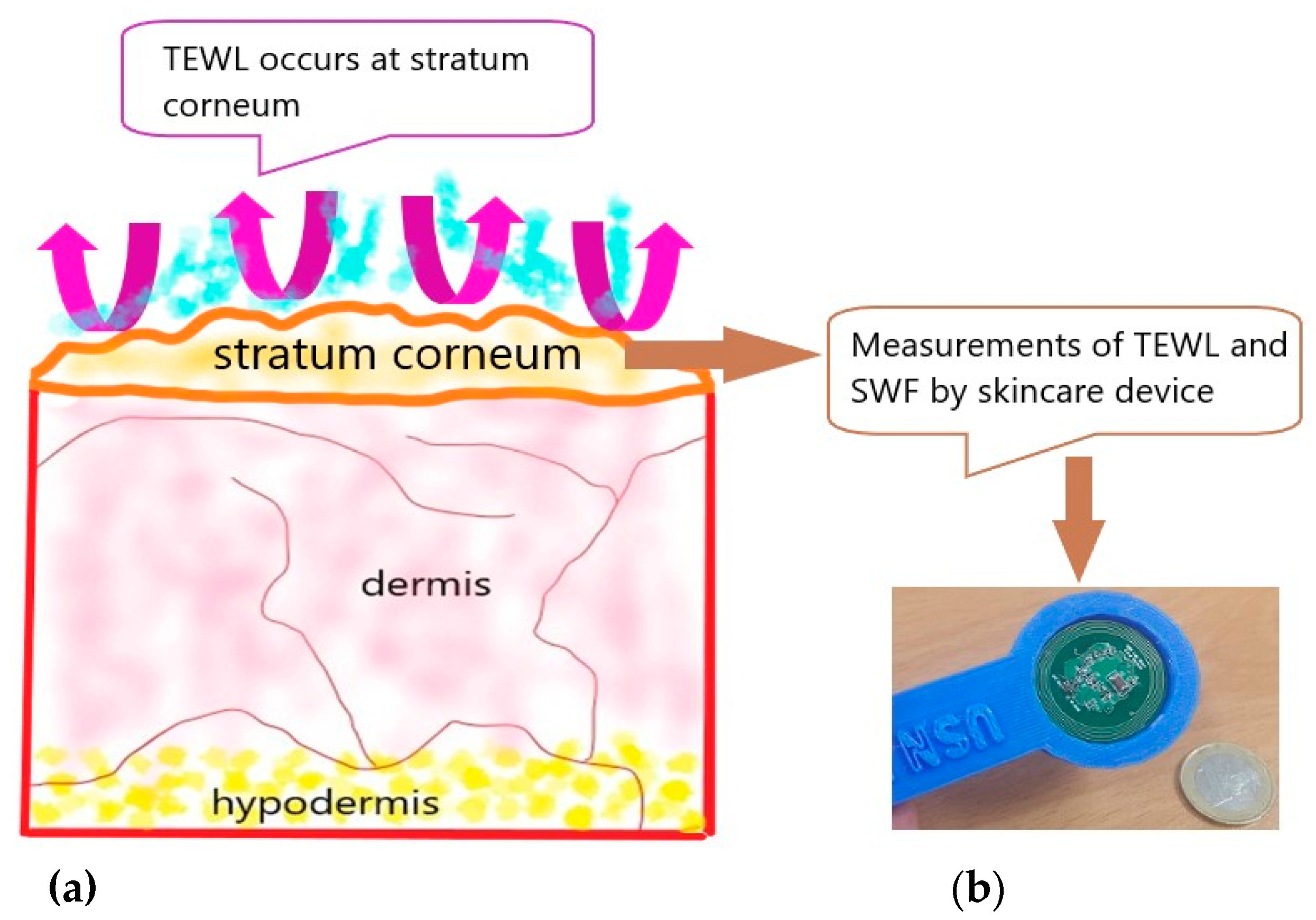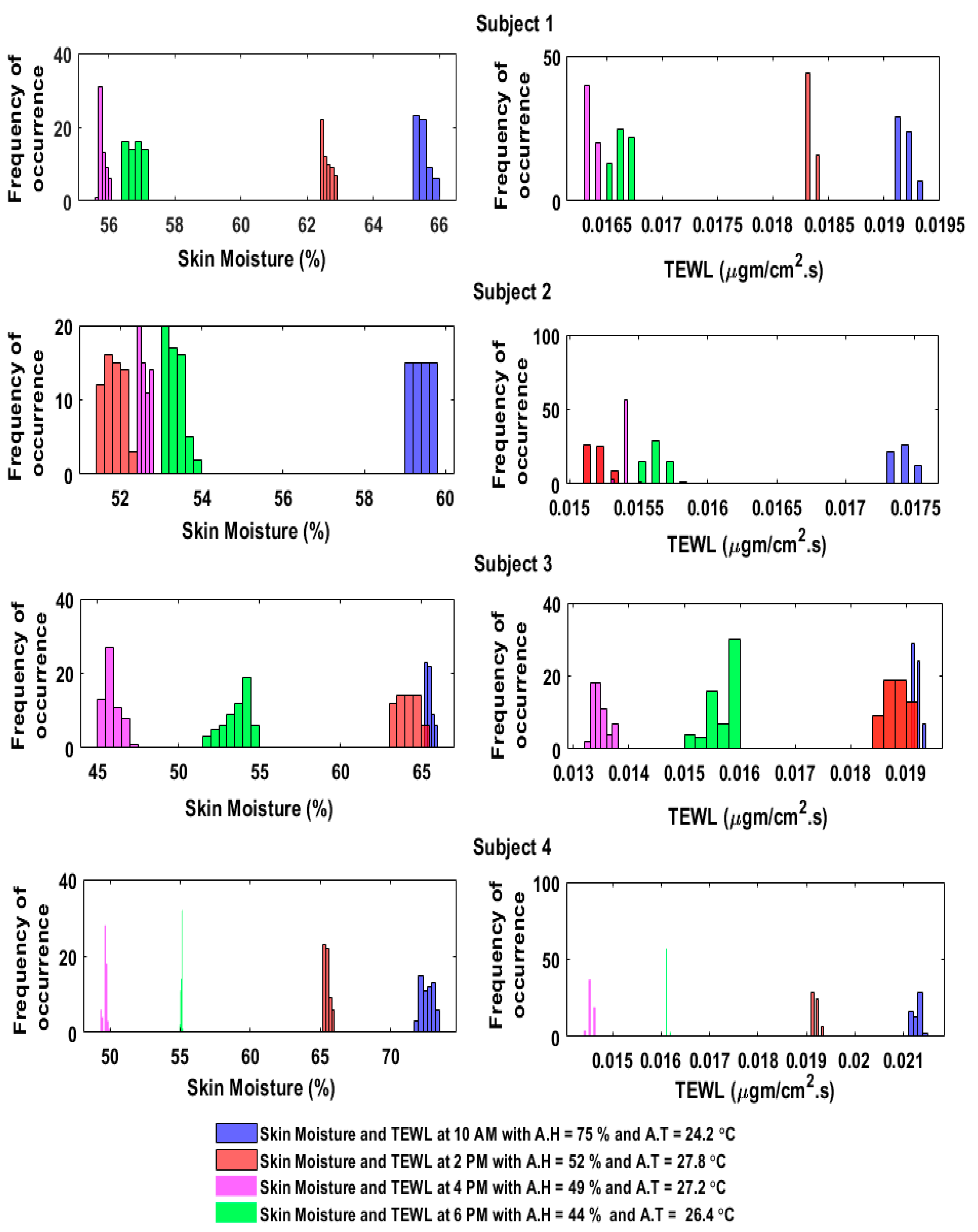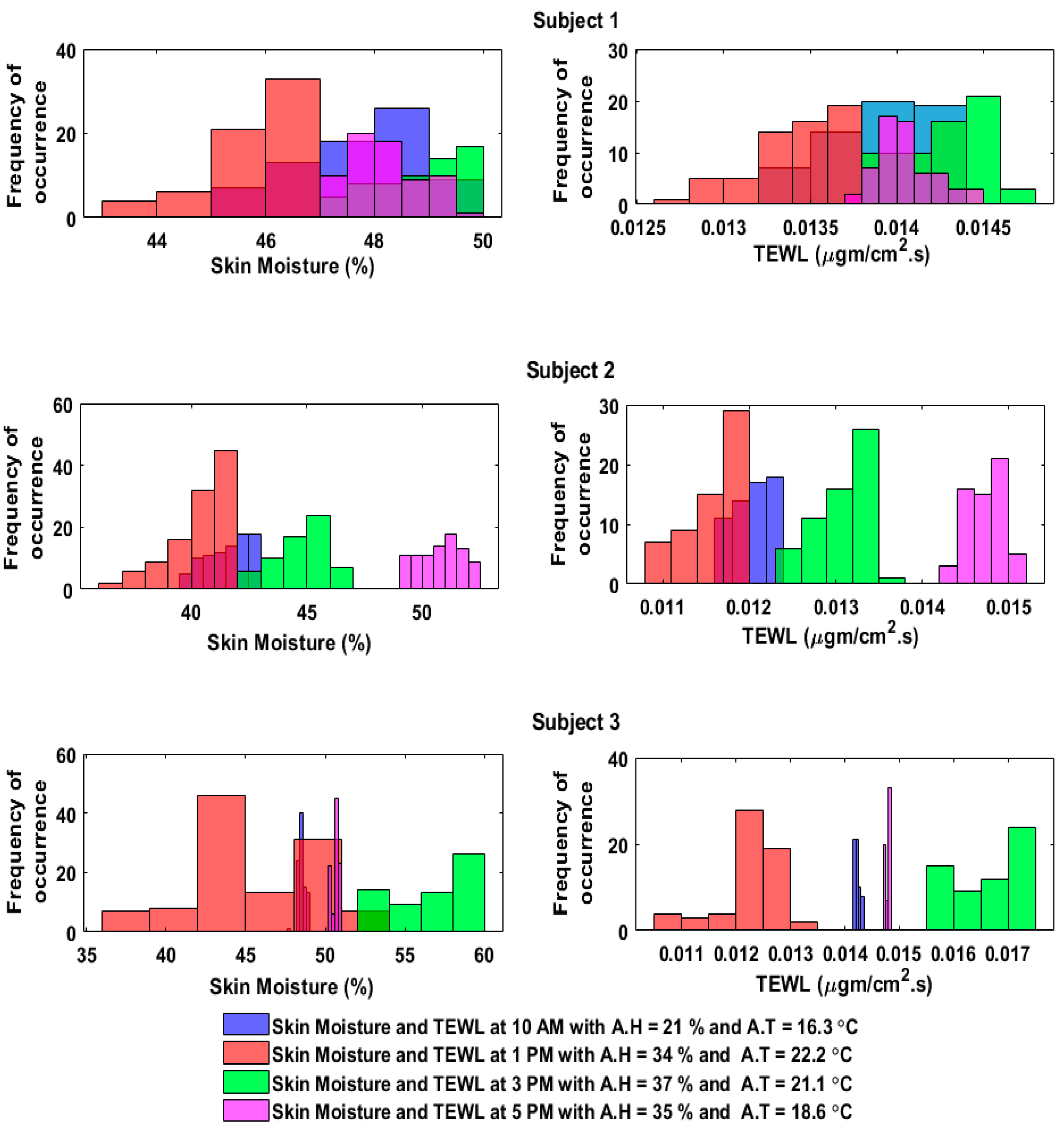Monitoring Transepidermal Water Loss and Skin Wettedness Factor with Battery-Free NFC Sensor
Abstract
:1. Introduction
2. Materials and Methods
2.1. TEWL Calculation
2.2. SWF Calculation
2.3. System Design
2.4. Android Application Design
3. Results
3.1. TEWL in the Indoor and Outdoor Environments
3.2. SWF Measurements in the Indoor and Outdoor Environments
4. Discussion
Author Contributions
Funding
Conflicts of Interest
References
- Sahle, F.F.; Gebre-Mariam, T.; Dobner, B.; Wohlrab, J.; Neubert, R.H.H. Skin diseases associated with the depletion of stratum corneum lipids and stratum corneum lipid substitution therapy. Skin Pharmacol. Physiol. 2015, 28, 42–55. [Google Scholar] [CrossRef]
- Krishnan, S.; Shi, Y.; Webb, R.C.; Ma, Y.; Bastien, P.; Crawford, K.E.; Wang, A.; Feng, X.; Manco, M.; Kurniawan, J.; et al. Multimodal epidermal devices for hydration monitoring. Microsyst. Nanoeng. 2017, 3, 17014. [Google Scholar] [CrossRef] [Green Version]
- Huang, X.; Liu, Y.; Cheng, H.; Shin, W.-J.; Fan, J.A.; Liu, Z.; Lu, C.-J.; Kong, G.-W.; Chen, K.; Patnaik, D.; et al. Materials and designs for wireless epidermal sensors of hydration and strain. Adv. Funct. Mater. 2014, 24, 3846–3854. [Google Scholar] [CrossRef]
- Wang, Y.; Qiu, Y.; Ameri, S.K.; Jang, H.; Dai, Z.; Huang, Y.; Lu, N. Low-cost, μm-thick, tape-free electronic tattoo sensors with minimized motion and sweat artifacts. Npj Flex. Electron. 2018, 2, 1–7. [Google Scholar] [CrossRef]
- Rizwan, A.; AbuAli, N.A.; Zoha, A.; Ozturk, M.; Alomainy, A.; Imran, M.; Abbasi, Q. Non-Invasive Hydration Level Estimation in Human Body Using Galvanic Skin Response. IEEE Sens. J. 2020, 20, 4891–4900. [Google Scholar] [CrossRef] [Green Version]
- Fukazawa, T.; Havenith, G. Differences in comfort perception in relation to local and whole body skin wettedness. Eur. J. Appl. Physiol. 2009, 106, 15–24. [Google Scholar] [CrossRef] [Green Version]
- Nilsson, G.E. Measurement of water exchange through skin. Med. Biol. Eng. Comput. 1977, 15, 209–218. [Google Scholar] [CrossRef]
- Imhof, R.E.; De Jesus, M.E.P.; Xiao, P.; Ciortea, L.I.; Berg, E.P. Closed-chamber transepidermal water loss measurement: Microclimate, calibration and performance. Int. J. Cosmet. Sci. 2009, 31, 97–118. [Google Scholar] [CrossRef] [PubMed]
- Farahmand, S.; Tien, L.; Hui, X.; Maibach, H.I. Measuring transepidermal water loss: A comparative in vivo study of condenser–chamber, unventilated–chamber and open–chamber systems. Skin Res. Technol. 2009, 15, 392–398. [Google Scholar] [CrossRef] [PubMed]
- Fluhr, J.W.; Feingold, K.R.; Elias, P.M. Transepidermal water loss reflects permeability barrier status: Validation in human and rodent in vivo and ex vivo models. Exp. Dermatol. 2006, 15, 483–492. [Google Scholar] [CrossRef] [PubMed]
- Alexander, H.; Brown, S.; Danby, S.; Flohr, C. Research Techniques Made Simple: Transepidermal Water Loss Measurement as a Research Tool. J. Investig. Dermatol. 2018, 138, 2295–2300. [Google Scholar] [CrossRef] [PubMed] [Green Version]
- Akdeniz, M.; Gabriel, S.; Lichterfeld-Kottner, A.; Blume-Peytavi, U.; Kottner, J. Transepidermal water loss in healthy adults: A systematic review and meta-analysis update. Br. J. Dermatol. 2018, 179, 1049–1055. [Google Scholar] [CrossRef] [PubMed]
- Rogiers, V. EEMCO Guidance for the Assessment of Transepidermal Water Loss in Cosmetic Sciences. Skin Pharmacol. Phy. 2001, 14, 117–128. [Google Scholar] [CrossRef] [PubMed]
- Du Plessis, J.; Stefaniak, A.; Eloff, F.; John, S.; Agner, T.; Chou, T.-C.; Nixon, R.; Steiner, M.; Franken, A.; Kudla, I.; et al. International guidelines for the in vivo assessment of skin properties in non-clinical settings: Part 2. transepidermal water loss and skin hydration. Skin Res. Technol. 2013, 19, 265–278. [Google Scholar] [CrossRef] [PubMed] [Green Version]
- Darlenski, R.; Sassning, S.; Tsankov, N.; Fluhr, J. Non-invasive in vivo methods for investigation of the skin barrier physical properties. Eur. J. Pharm. Biopharm. 2009, 72, 295–303. [Google Scholar] [CrossRef] [PubMed]
- Valentin, B.; Mundlein, M.; Chabicovsky, R. Evaluation of a novel transepidermal water loss sensor. In Proceedings of the IEEE Sensors Conference, Vienna, Austria, 24–27 October 2004; pp. 115–118. [Google Scholar]
- Gioia, F.; Celleno, L. The dynamics of transepidermal water loss (TEWL) from hydrated skin. Skin Res. Technol. 2002, 8, 178–186. [Google Scholar] [CrossRef]
- Gagge, A.P.; Stolwijk, J.A.J.; Hardy, J.D. Comfort and thermal sensations and associated physiological responses at various ambient temperatures. Environ. Res. 1967, 1, 1–20. [Google Scholar] [CrossRef]
- Filingeri, D.; Redortier, B.; Hodder, S.; Havenith, G. The role of decreasing contact temperatures and skin cooling in the perception of skin wettedness. Neurosci. Lett. 2013, 55, 65–69. [Google Scholar] [CrossRef] [Green Version]
- Eudier, F.; Savary, G.; Grisel, M.; Picard, C. Skin surface physio-chemistry: Characteristics, methods of measurement, influencing factors and future developments. Adv. Colloid Interface Sci. 2019, 264, 11–27. [Google Scholar] [CrossRef]
- Gagge, A.P.; Stolwijk, J.A.J.; Nishi, Y. The prediction of thermal comfort when thermal equilibrium is maintained by sweating. ASHRAE Trans. 1969, 75, 108–122. [Google Scholar]
- Gonzalez, R.; Gagge, A.P. Magnitude estimates of thermal discomfort during transients of humidity and operative temperature and their relation to the new ASHRAE effective temperature (ET). ASHRAE Trans. 1973, 79, 88–96. [Google Scholar]
- Nishi, Y.; Gagge, A.P. Effective temperature scale useful for hypo- and hyperbaric environments. Aviat. Space Environ. Med. 1977, 48, 97–107. [Google Scholar] [PubMed]
- Sweeney, M.M.; Branson, D.H. Sensorial comfort: Part I: A psychophysical method for assessing moisture sensation in clothing. Text Res. J. 1990, 60, 371–377. [Google Scholar] [CrossRef]
- Sweeney, M.M.; Branson, D.H. Sensorial comfort: Part II: A magnitude estimation approach for assessing moisture sensation 1. Text Res. J. 1990, 60, 447–452. [Google Scholar] [CrossRef]
- Li, Y. Perceptions of temperature, moisture and comfort in clothing during environmental transients. Ergonomics 2007, 48, 234–248. [Google Scholar] [CrossRef]
- Daanen, H.A.M. Method and System for Alerting the Occurrence of Wettedness. U.S. Patent No. 8,697,935 B2, 15 April 2014. [Google Scholar]
- Niedermann, R.; Rossi, R.M. Objective and subjective evaluation of the human thermal sensation of wet fabrics. Text Res. J. 2012, 82, 374–384. [Google Scholar] [CrossRef]
- Lee, J.Y.; Nakao, K.; Tochihara, Y. Validity of perceived skin wettedness mapping to evaluate heat strain. Eur. J. Appl. Physiol. 2011, 111, 2581–2591. [Google Scholar] [CrossRef]
- Youbok, L. Antenna Circuit Design for RFID Applications; Microchip Tech. Inc.: Chandler, AZ, USA, 2003. [Google Scholar]
- Marrocco, G. Pervasive electromagnetics: Sensing paradigms by passive RFID technology. IEEE Wirel. Commun. 2010, 17, 10–17. [Google Scholar] [CrossRef]
- Babar, A.; Manzari, S.; Sydanheimo, L.; Elsherbeni, A.; Ukkonen, L. Passive UHF RFID tag for heat sensing applications. IEEE Trans. Antennas Propag. 2012, 60, 4056–4064. [Google Scholar] [CrossRef]
- Fernández-Salmerón, J.; Rivadeneyra, A.; Martínez-Martí, F.; Capitán-Vallvey, L.F.; Palma, A.J.; Carvajal, M.A. Passive UHF RFID tag with multiple sensing capabilities. Sensors 2015, 15, 26769–26782. [Google Scholar] [CrossRef] [Green Version]
- Boada, M.; Lázaro, A.; Villarino, R.; Girbau, D. Battery-less soil moisture measurement system based on a NFC device with energy harvesting capability. IEEE Sens. J. 2018, 18, 5541–5549. [Google Scholar] [CrossRef]
- Lázaro, A.; Boada, M.; Villarino, R.; Girbau, D. Color measurement and analysis of fruit with a battery-less NFC sensor. Sensors 2019, 19, 1741. [Google Scholar] [CrossRef] [PubMed] [Green Version]
- Boada, M.; Lazaro, A.; Villarino, R.; Girbau, D. Battery-less NFC sensor for pH monitoring. IEEE Access. 2019, 7, 33226–33239. [Google Scholar] [CrossRef]
- Lieb, L.M.; Nash, R.A.; Matias, J.R.; Orentreich, N. A new in vitro method for transepidermal water loss: A possible method for moisturizer evaluation. J. Soc. Cosmet. Chem. 1988, 39, 107–119. [Google Scholar]
- Nagayama, K.; Kurihara, T. Numerical Simulation of Skin Formation: The Relationship between Transepidermal Water Loss and Corneum Thickness. J. Appl. Math. Phys. 2018, 6, 1757–1762. [Google Scholar] [CrossRef] [Green Version]
- Stockdale, M. Water diffusion coefficients versus water activity in stratum corneum: A correlation and its implications. J. Soc. Cosmet. Chem. 1978, 29, 625–639. [Google Scholar]
- Sun, Y.; Jasper, W.J. Numerical modeling of heat and moisture transfer in a wearable convective cooling system for human comfort. Build. Environ. 2015, 93, 50–62. [Google Scholar] [CrossRef]













© 2020 by the authors. Licensee MDPI, Basel, Switzerland. This article is an open access article distributed under the terms and conditions of the Creative Commons Attribution (CC BY) license (http://creativecommons.org/licenses/by/4.0/).
Share and Cite
Ali, S.M.; Chung, W.-Y. Monitoring Transepidermal Water Loss and Skin Wettedness Factor with Battery-Free NFC Sensor. Sensors 2020, 20, 5549. https://doi.org/10.3390/s20195549
Ali SM, Chung W-Y. Monitoring Transepidermal Water Loss and Skin Wettedness Factor with Battery-Free NFC Sensor. Sensors. 2020; 20(19):5549. https://doi.org/10.3390/s20195549
Chicago/Turabian StyleAli, Syed Muhammad, and Wan-Young Chung. 2020. "Monitoring Transepidermal Water Loss and Skin Wettedness Factor with Battery-Free NFC Sensor" Sensors 20, no. 19: 5549. https://doi.org/10.3390/s20195549
APA StyleAli, S. M., & Chung, W.-Y. (2020). Monitoring Transepidermal Water Loss and Skin Wettedness Factor with Battery-Free NFC Sensor. Sensors, 20(19), 5549. https://doi.org/10.3390/s20195549





